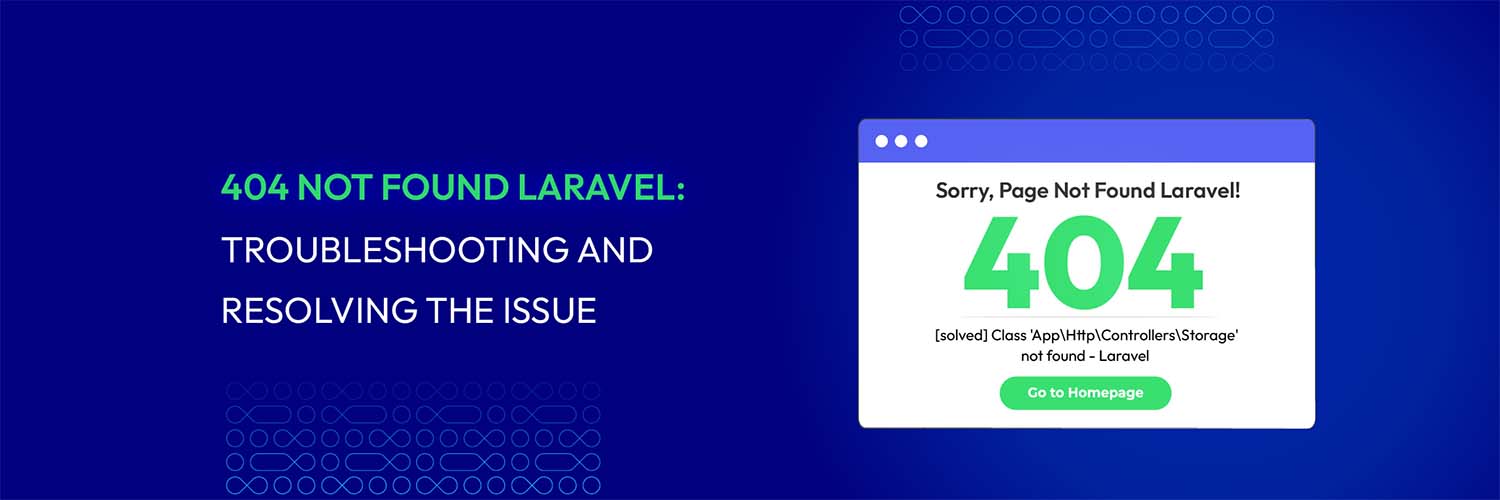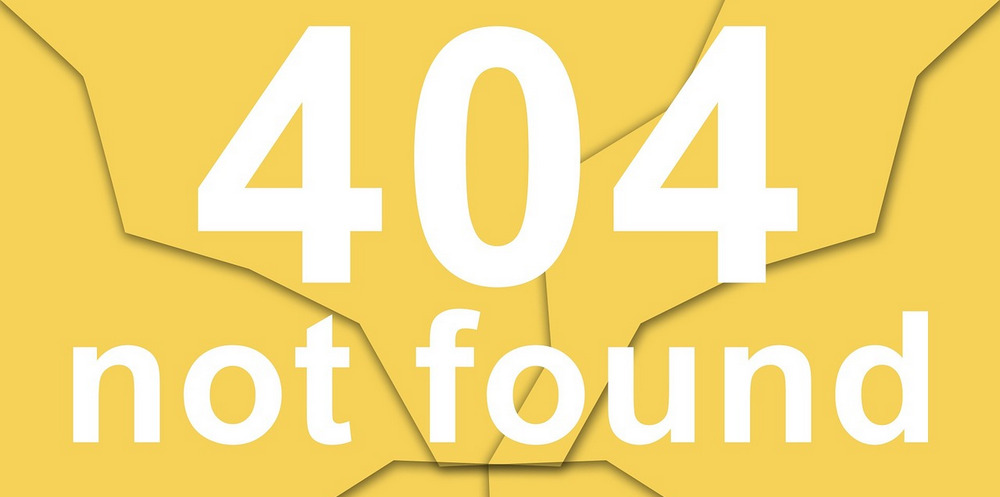404 Not Found Laravel: Troubleshooting And Resolving The Issue
Vinh Jacker | 07-27-2023

The 404 Not Found Laravel error is a common error in web development, including Laravel applications. When getting this error in a Laravel project, it means the requested resource or route could not be found.
However, don’t fret! With the right troubleshooting techniques and knowledge, we’ll help you solve this problem simply.
What is 404 Not Found Laravel?
In the context of Laravel, “404 Not Found” refers to an HTTP status code that is returned when a requested resource cannot be found on a web server. Laravel is a popular PHP framework for web development.

When a Laravel application receives a request for a particular route or resource, it tries to locate and process the corresponding code or file associated with that request. Laravel will typically return a “404 Not Found” response if the requested resource cannot be found.
This response informs the client (usually a web browser) that the requested resource could not be located on the server. It’s a standard HTTP status code used to indicate that the server could not find the requested resource.
Laravel provides built-in functionality to handle and customize the 404 Not Found Laravel response. You can define custom error pages or responses for different HTTP status codes, including the 404 error. By customizing the error page, you can display a user-friendly message or provide additional instructions to the user when a requested resource is not found.
Want a deeper dive into 404 Not Found? This article has you covered: 404 Not Found Page: Unlocking the Secret of the Broken Links.
Cause of Error 404 Not Found in Laravel
There can be several reasons for 404 Not Found in Laravel. Here are some common causes:
-
Incorrect URL or route: One of the most common causes is entering an incorrect URL or route. Ensure that the URL or route you are accessing is correct and matches the one defined in your Laravel application’s routes.
-
Missing route definition: If you haven’t defined a route for the requested URL, Laravel will return a “404 Not Found” error. Ensure you have defined the appropriate route in your routes file (e.g., web.php or api.php) for the requested URL.
-
Missing file or resource: If you are trying to access a file or resource that doesn’t exist, Laravel will return a “404 Not Found” error. Double-check that the file or resource you are trying to access is present in the correct location.
-
Incorrect HTTP verb: Laravel uses different HTTP verbs (GET, POST, PUT, DELETE, etc.) to handle different requests. If you’re using the wrong HTTP verb for a particular route, Laravel may return a “404 Not Found” error. Ensure that you’re using the correct HTTP verb for the intended action.
-
Route caching: If you have enabled route caching in your Laravel application (php artisan route:cache), clear the route cache whenever you make changes to your routes. Failure to clear the route cache can lead to Laravel returning a “404 Not Found” error for updated routes.
-
Incorrect file permissions: If the web server doesn’t have proper permissions to access a file or directory, it can lead to the error 404 Not Found Laravel. Ensure that the necessary file and directory permissions are set correctly.
-
Server configuration: Sometimes, the server configuration can cause “404 Not Found” errors. Ensure that your web server (e.g. Apache or Nginx) is properly configured to handle Laravel applications and rewrite URLs correctly.
Impact of the Error 404 Not Found in Laravel
The “404 Not Found” error in Laravel can have several impacts on your application and its users:

-
User experience: When a visitor encounters a “404 Not Found” error, it indicates that the requested resource is not available. This can lead to a poor user experience as users may become frustrated or confused. It’s important to handle the error gracefully and provide users with helpful information or suggestions on how to proceed.
-
Loss of trust and credibility: If users frequently encounter “404 Not Found” errors on your application, it can erode their trust in your website or service. They may perceive it as a sign of poor maintenance or outdated content, which can negatively impact your brand reputation.
-
SEO (Search Engine Optimization) impact: Search engines crawl and index web pages based on their availability and relevance. If search engines encounter multiple 404 Not Found Laravel errors while crawling your site, it can affect your SEO rankings. Broken links or missing pages can lead to a decrease in organic search traffic and visibility.
-
Missed opportunities: “404 Not Found” errors can result in missed opportunities for conversions or engagement. If a visitor tries to access a specific page or resource that is not found, they may abandon the site or look for alternatives. This can lead to lost sales, sign-ups, or other desired user actions.
-
Development and debugging: From a development perspective, encountering a 404 Not Found Laravel error can indicate potential issues in your code, such as incorrect routing or missing files. It indicates that certain routes or resources need to be reviewed and fixed.
6 Troubleshooting Techniques for the 404 Not Found Laravel
When encountering a 404 Not Found in Laravel, you can use several troubleshooting techniques to identify and resolve the issue. Here are six techniques you can try:
1. Checking the Route Configuration
One of the primary causes of the “404 Not Found” error in Laravel is incorrect route configuration. Ensure that the route you are trying to access is correctly defined in your Laravel application’s route files (web.php, api.php, etc.).

Pay attention to the URL pattern, HTTP verb, and any route parameters. Verify that they match the intended route. If there are any mistakes or inconsistencies, correct them to ensure the route is properly defined.

2. Examining the Controller and Action Methods
Laravel uses controllers to handle requests and process actions. If you encounter a 404 Not Found Laravel error, it’s essential to verify that the associated controller and action methods exist and are spelled correctly.

Check the namespace, class name, and method name in your route definition and the corresponding controller file. Any discrepancies or typos in these names can lead to the error. Correct any naming errors to ensure the controller and action method are correctly referenced.
3. Reviewing the File and Directory Structure
Another possible cause of the 404 Not Found Laravel error is an issue with the file and directory structure in your Laravel application. Ensure that the file or resource you’re trying to access exists in the correct location within the project’s file structure.
Double-check the presence of the file, naming conventions, and any necessary subdirectories. In case the file or resource is not found in the expected location, adjust the file and directory structure accordingly.
4. Debugging the Database Connection
If your application involves database operations, a “404 Not Found” error may occur due to a problem with the database connection. Check your database configuration in Laravel’s .env file.

Verify the accuracy of the database credentials, host, and port. Ensure the database server is accessible and the connection details are correctly specified. Troubleshoot any database connection issues to resolve the error.
5. Inspecting the HTTP Server Configuration
The web server (e.g., Apache or Nginx) is crucial in serving your Laravel application. If the server configuration is incorrect or incomplete, it can lead to a 404 Not Found Laravel error.
Review your web server’s configuration and ensure it is correctly set up to handle Laravel applications. Check for any required rewrite rules, virtual host configurations, or server requirements specific to Laravel. Make any necessary adjustments to the server configuration to resolve the error.

6. Investigating the Presence of Middleware
Middleware in Laravel provides a way to intercept requests and perform actions before they reach the intended route. One or more middleware components may interfere with the route and cause the “404 Not Found” error.

Examine the middleware logic in your application and verify that it is not blocking or redirecting the request incorrectly. Specifically, check if any middleware is applied to the specific route you are trying to access. Adjust the middleware configuration if necessary to ensure it doesn’t interfere with the routing process.
Remember to thoroughly test your application after making any changes to ensure the error is resolved and the desired functionality is restored.
Best Practices to Avoid the 404 Not Found Error in Laravel
To avoid the Laravel 404 Not Found error, you can follow these best practices:
1. Implementing Proper Route Naming and Resourceful Routing
Giving meaningful names to your routes can enhance code readability and maintainability. Use descriptive names that accurately describe the action being performed.
Additionally, utilize Laravel’s resourceful routing feature to define routes for CRUD (Create, Read, Update, Delete) operations on a resource. This promotes consistency in route naming and reduces the chances of incorrect or missing routes.
2. Writing Robust and Error-Handling Controllers
Controllers play a crucial role in handling requests and executing application logic. Ensure that your controllers are robust by incorporating error-handling mechanisms.
Implement proper error responses, such as returning specific HTTP status codes (e.g., 404 for resources not found) when necessary. Use Laravel’s exception-handling mechanism to catch and handle exceptions gracefully, providing informative error messages or redirects as needed. This helps users understand and recover from errors effectively.
3. Regularly Update Dependencies and Laravel Version
Keeping your Laravel application updated with the latest framework version and dependencies is important. Laravel regularly releases updates that include bug fixes, performance improvements, and security patches.
By staying current, you can prevent potential issues and reduce the chances of encountering 404 Not Found Laravel errors due to outdated or incompatible dependencies.
4. Testing Routes and Performing Thorough Quality Assurance
Testing is critical to ensuring your application’s reliability and correctness. Create comprehensive unit, feature, and integration tests to cover different scenarios, including testing routes.
Test for both success and error responses, including 404 Not Found Laravel scenarios. Laravel’s testing framework provides helpful tools and utilities for automated testing, allowing you to catch potential issues early on and ensure the proper functioning of your routes.

5. Implement Proper Error Handling and Logging
Laravel offers robust error handling and logging capabilities. Set up appropriate error handling configurations to catch and log errors and exceptions within your application.
You can quickly identify and resolve issues that may lead to “404 Not Found” errors by logging errors. Laravel’s logging features provide detailed logs with relevant information, helping you trace the root cause of errors and make necessary adjustments to prevent future occurrences.
6. Use Route Caching and Optimize Performance
Laravel provides route caching as a performance optimization technique. After thoroughly testing your routes, consider caching them using the php artisan route:cache command. This caches the route information, reducing the processing required for route resolution.
By minimizing the overhead of route handling, you can prevent “404 Not Found” errors caused by misconfigured or missing routes, while also improving the overall performance of your application.
Check this out — it might catch your attention: How to Fix 405 Method Not Allowed? [Actionable Guide] .
Conclusion
Troubleshooting and resolving the 404 Not Found Laravel error requires a combination of technical knowledge, attention to detail, and adherence to best practices. By leveraging the troubleshooting techniques and implementing the suggested preventive measures, developers can overcome this error and deliver exceptional user experiences in their Laravel applications.





![Top 20+ Must-have Shopify Apps for 2025 [Free & Paid] - Mageplaza](https://cdn2.mageplaza.com/media/blog/must-have-shopify-apps/top-must-have-shopify-apps.png)
![[2025 Updates] Top 10+ Upsell Apps for Shopify - Mageplaza](https://cdn2.mageplaza.com/media/blog/best-upsell-shopify-app/cover.png)